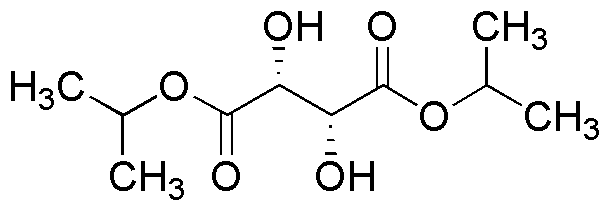(+)-Diisopropyl L-tartrate is widely utilized in research focused on
- Chiral Resolution: This compound is essential in the pharmaceutical industry for separating enantiomers, which is crucial for developing effective and safe medications.
- Asymmetric Synthesis: It serves as a chiral auxiliary in asymmetric synthesis, helping chemists create specific molecules with desired configurations, enhancing the efficiency of drug development.
- Food and Beverage Industry: Used as a flavoring agent, it contributes to the development of unique taste profiles in food products, making it valuable for food scientists and manufacturers.
- Cosmetic Formulations: Its properties make it suitable for use in cosmetic products, providing stability and enhancing the texture of creams and lotions.
- Research Applications: In academic settings, it is utilized in various organic synthesis experiments, aiding students and researchers in understanding stereochemistry and reaction mechanisms.
General Information
Properties
Safety and Regulations
Applications
(+)-Diisopropyl L-tartrate is widely utilized in research focused on
- Chiral Resolution: This compound is essential in the pharmaceutical industry for separating enantiomers, which is crucial for developing effective and safe medications.
- Asymmetric Synthesis: It serves as a chiral auxiliary in asymmetric synthesis, helping chemists create specific molecules with desired configurations, enhancing the efficiency of drug development.
- Food and Beverage Industry: Used as a flavoring agent, it contributes to the development of unique taste profiles in food products, making it valuable for food scientists and manufacturers.
- Cosmetic Formulations: Its properties make it suitable for use in cosmetic products, providing stability and enhancing the texture of creams and lotions.
- Research Applications: In academic settings, it is utilized in various organic synthesis experiments, aiding students and researchers in understanding stereochemistry and reaction mechanisms.
Documents
Safety Data Sheets (SDS)
The SDS provides comprehensive safety information on handling, storage, and disposal of the product.
Product Specification (PS)
The PS provides a comprehensive breakdown of the product’s properties, including chemical composition, physical state, purity, and storage requirements. It also details acceptable quality ranges and the product's intended applications.
Certificates of Analysis (COA)
Search for Certificates of Analysis (COA) by entering the products Lot Number. Lot and Batch Numbers can be found on a product’s label following the words ‘Lot’ or ‘Batch’.
*Catalog Number
*Lot Number
Certificates Of Origin (COO)
This COO confirms the country where the product was manufactured, and also details the materials and components used in it and whether it is derived from natural, synthetic, or other specific sources. This certificate may be required for customs, trade, and regulatory compliance.
*Catalog Number
*Lot Number
Safety Data Sheets (SDS)
The SDS provides comprehensive safety information on handling, storage, and disposal of the product.
DownloadProduct Specification (PS)
The PS provides a comprehensive breakdown of the product’s properties, including chemical composition, physical state, purity, and storage requirements. It also details acceptable quality ranges and the product's intended applications.
DownloadCertificates of Analysis (COA)
Search for Certificates of Analysis (COA) by entering the products Lot Number. Lot and Batch Numbers can be found on a product’s label following the words ‘Lot’ or ‘Batch’.
*Catalog Number
*Lot Number
Certificates Of Origin (COO)
This COO confirms the country where the product was manufactured, and also details the materials and components used in it and whether it is derived from natural, synthetic, or other specific sources. This certificate may be required for customs, trade, and regulatory compliance.

